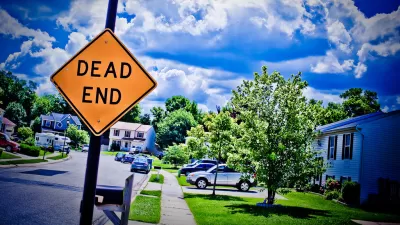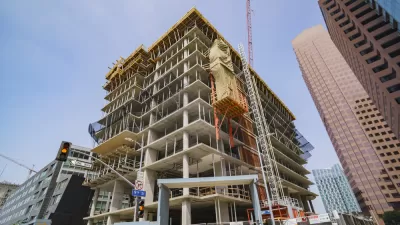Aaron Renn presents a new model for conceptualizing the health of the many layers of communities that make up metropolitan regions, namely the "new donut."
The "old donut: "The idea being that you can’t have a smoking hole in your region where your downtown is supposed to be." Decades of reinvestment and an influx of residents to urban cores, however, have created a new model, according to Renn, in which the "old donut" has been filled in, leaving a "new donut":
In this model, the old donut is inverted. What used to be the ring of health – the outer areas of the city and the inner suburban regions – are now struggling. Whereas the downtown is in pretty good shape, and the newer suburban areas are booming.
But here's the rub: "We’ve got three decades of experience in downtown revitalization, but much less in dealing with this newer challenge zone." The challenges of reinvesting in such a "newer challenge zone" are numerous, according to Renn:
These areas have an inferior housing stock (often small post-war worker cottages or ranches), sometimes poor basic infrastructure, and are sometimes independent municipalities that, like Ferguson, MO, are often overlooked unless something really bad happens. Unlike the major downtown, they are often “out of sight, out of mind” for most regional movers and shakers.
Renn's coverage also includes more about the implications of the new model and recommends first steps in addressing the challenges created by the "new donut."
Writing for Corner Side Yard, Pete Saunders picks up on Renn's article and recommends a thought experiment for the metropolitan area of Chicago that he uses to show the unintended, and undesirable, consequences of a potential response to Renn's new model: a ban on exclusionary zoning.
FULL STORY: The New Donut

Study: Maui’s Plan to Convert Vacation Rentals to Long-Term Housing Could Cause Nearly $1 Billion Economic Loss
The plan would reduce visitor accommodation by 25,% resulting in 1,900 jobs lost.

North Texas Transit Leaders Tout Benefits of TOD for Growing Region
At a summit focused on transit-oriented development, policymakers discussed how North Texas’ expanded light rail system can serve as a tool for economic growth.

Why Should We Subsidize Public Transportation?
Many public transit agencies face financial stress due to rising costs, declining fare revenue, and declining subsidies. Transit advocates must provide a strong business case for increasing public transit funding.

How to Make US Trains Faster
Changes to boarding platforms and a switch to electric trains could improve U.S. passenger rail service without the added cost of high-speed rail.

Columbia’s Revitalized ‘Loop’ Is a Hub for Local Entrepreneurs
A focus on small businesses is helping a commercial corridor in Columbia, Missouri thrive.

Invasive Insect Threatens Minnesota’s Ash Forests
The Emerald Ash Borer is a rapidly spreading invasive pest threatening Minnesota’s ash trees, and homeowners are encouraged to plant diverse replacement species, avoid moving ash firewood, and monitor for signs of infestation.
Urban Design for Planners 1: Software Tools
This six-course series explores essential urban design concepts using open source software and equips planners with the tools they need to participate fully in the urban design process.
Planning for Universal Design
Learn the tools for implementing Universal Design in planning regulations.
City of Santa Clarita
Ascent Environmental
Institute for Housing and Urban Development Studies (IHS)
City of Grandview
Harvard GSD Executive Education
Toledo-Lucas County Plan Commissions
Salt Lake City
NYU Wagner Graduate School of Public Service





























